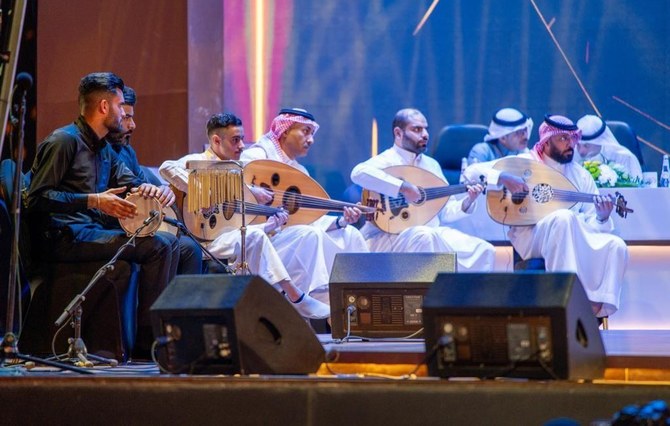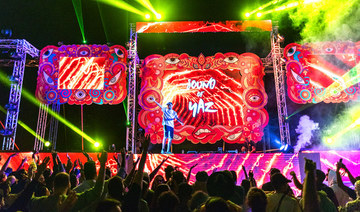Mohammed Al-Saleem

‘Untitled’
Al-Saleem was one of the Kingdom’s most significant artists, who has, as the Sotheby’s show brochure notes, “greatly contributed to the growth and evolution of Saudi art in the Kingdom.”
In the 1980s, Al-Saleem developed a style he called “Al-Afakia” (Horizonism), which was “inspired by the gradating skyline of Riyadh from the desert.” This piece from 1986 is a prime example of that style, which balances modernist and traditional aesthetics, and demonstrates why Al-Saleem was widely regarded as the leading abstract artist of his generation in the Kingdom and the wider Gulf region.
“(This work) banishes form and landscape, reimagining the distant dunes of the desert horizon through contained slabs of color, which emerge as if struggling against one another across the surface of the image,” the brochure states. “Its layering and shading suggest a search for subtle accords and variations similar to that with which a composer achieves musical harmony, creating an astonishing sense of energy and dynamism.”
Abduljabbar Al-Yahya

‘Flask’
Another pioneer of Saudi modern art, Al-Yahya’s first solo exhibition was held in 1971, before his “stylistic tendencies” transitioned into what Sotheby’s calls “his recognizable oeuvre, characterized by its ability to convey the beauty and complexity of his country’s landscape, culture and people. In this piece, created in 2000, the brochure states, “Al Yahya depicts a female figure against a kaleidoscopic form that her figure merges into, further bordered by a golden background. Recalling the spirit and silt of Saudi Arabia’s landscape, Al Yahya’s canvases are habitats of earthy hues and architectural flatness, balanced against a figurative abstraction derived from his time in Europe. Ultimately foregrounding these explorations was Al Yahya’s focus on the notion of belonging, to both nature and humanity.”
Al-Yahya himself once said of his work: “I followed the theme ‘art for life.’ Art is not only a hobby or entertainment. I strongly believe that I have a message I must achieve … (delivering) an idea bringing hope to the human being … I know my humanity through art.”
Abdulhalim Radwi

‘Untitled’
The late artist (who was also a prolific sculptor and poet) studied in Rome in the 1960s, where he began to take an interest in abstraction. But, as Sotheby’s notes, “though he was absorbed by Western artistic discourses, Radwi never strayed far from local heritage and traditions, and instead invoked his own narrative of the Arab world through cubism and expressionism which set himself apart from his contemporaries. This work was created in 1989 and is, the brochure states, “exemplary of Radwi’s later paintings” and an “attempt to reconcile modernity and artistic authenticity.”
It continues: “‘Untitled’ is kaleidoscopic in its composition, with a scene that is imbued with the effervescent bustling energy — the vivacity of popular life — in the old towns of his beloved Saudi Arabia. The vibrancy of the city is depicted through a futurist scene blending traditional Ottoman architecture with contemporary influences. Radwi borrows the swift strokes and striking hues of Cezanne and Van Gogh, and similarly imbues his canvas with an effervescent, almost cosmic, energy. The very essence of his works lies not in their physicality but in the emotions they trigger.”
Abdulrahman Al-Soliman

‘Untitled’
The Al-Ahsa-born artist’s works, Sotheby’s says, “convey a deep appreciation for Saudi Arabia’s culture and heritage.” He was particularly concerned with the “erasure of heritage that exists on a personal and collective plane.” This specific “rare cubist” work, created in 1980, was “produced amid a transitional period in Saudi” and can be “set against a backdrop of social shifts, as Saudi society steered towards a more conservative societal trajectory,” the brochure states. “There is a delicacy depicted through the simplicity of Al-Soliman’s subtle use of lines, colors, shadows that convey a certain peacefulness. Furthermore, the subject bears testimony to the artist’s love of his country, a place he calls home. One can engage in a graceful nostalgia delivered through this early cubist work.”
Mohammed Al-Resayes

‘Architectural Element 5’
After finishing high school in Riyadh in the Seventies, Al-Resayes traveled to Cairo to learn more about art. There, Sotheby’s says, his practice focused on “attempting to integrate the brushstroke techniques of Impressionism with the contracted, reassembled space of Cubism, depicting sceneries reminiscent of his rural background.” In the Nineties, having returned to the Kingdom, Al-Resayes “became involved with the emergent expressionist movement of the Saudi pioneers who preceded him,” and became president of the art department at the King Saud University. The 1982 series “Architectural Elements,” to which this work — depicting three vertical forms that could be interpreted as three figures crouching slightly — belongs, revolved, according to Sotheby’s “around exile, pain and misery.”
Arwa Alneami

‘Spring Camel’
Alneami’s practice, Sotheby’s says, “interrogates themes of acceptance and inclusion within Saudi society” and “reflects her own experiences as a female artist, (having) struggled to integrate in the regional contemporary arts environment.” She can be regarded as something of a trailblazer, having been the first woman to photograph inside the Prophet’s Mosque in Madinah (a project exhibited in the British Museum). This piece from 2012, Alneami told the Royal Arts Magazine, is an “homage to the best friend of the desert. Not to that cliché subject ‘camels for tourism,’ but to that loyal companion of humans … Camels as celebration, colorfully festive, welcoming the Springtime, eternal symbols of the endless journey, travelers and travel, silent, hardworking, melancholic and trustful. Again, an artistic subject based on the souvenirs of the past.”




























